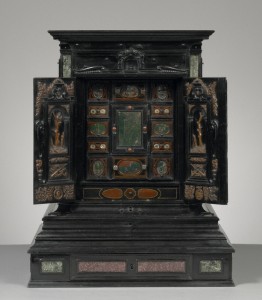 The J. Paul Getty Museum has utilized a technology called Augmented Reality to display the details of a collector’s cabinet from Augsburg, Germany, (made ca. 1630). The cabinet is an incredibly complex piece of furniture that was designed to showcase its owners’ most precious collectibles. It opens on four sides to expose a bewildering array of drawers, cubbies and richly decorated surfaces.
The J. Paul Getty Museum has utilized a technology called Augmented Reality to display the details of a collector’s cabinet from Augsburg, Germany, (made ca. 1630). The cabinet is an incredibly complex piece of furniture that was designed to showcase its owners’ most precious collectibles. It opens on four sides to expose a bewildering array of drawers, cubbies and richly decorated surfaces.
Visitors aren’t allowed to touch it, of course — it’s a delicate piece — so the Getty decided to provide a virtual experience of the cabinet’s wonders both for the museum visitors and for visitors to its website.
“We are always looking for ways in which we can enhance the viewer’s experience,” says Erin Coburn, head of the museum’s Collection Information & Access department. During a discussion about the pavilion’s reopening, she says, “A curator suggested we do something to help people understand the Augsberg cabinet in a way other than just staring at it.”
Coburn and her colleagues created an “interactive” — a virtual model that computer users can spin, open and reassemble. This model is accessible via two touch screens in the gallery and on the Getty’s website at http://www.getty.edu/art/exhibitions/north_pavilion/cabinet/index.html.
The Getty also has enabled online computer users to view and interact with a floating 3-D simulation of the cabinet, thanks to Augmented Reality technology, which combines the real and the virtual in real time.
There’s a wee delay while it loads, but nothing dramatic. Not only can you move all the way around it and zoom in to every section, but there are explanatory details on the most salient features of each side. Click on the “Overview” button for an awesome animation of the whole cabinet spinning around with its drawers pulled out. When you click “Show Structure” the outer walls go transparent and you can see the guts of the piece, exploring all kinds of drawers and pull-out trays in annotated detail.
I love it when technology makes history accessible. No more roped off velvet chairs and plexiglass walls keeping our collective grubby hands off of beautiful, fascinating objects.
Protip: It plays a little better in Firefox than it does in Internet Explorer. Mainly the browsers both handle it fine, but IE gave me trouble when I tried to click on the drawers and pull-outs in the “Show Structure” mode.